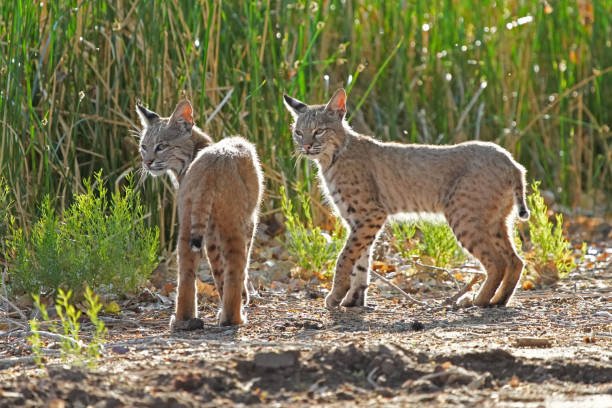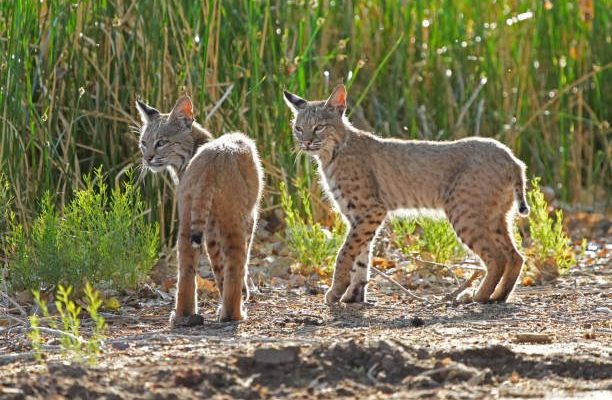
Honestly, bobcats make parenting look easy—at least from our perspective! They’re solitary animals, which means they go about life mostly on their own, but when it comes to their offspring, they transform into devoted caregivers. They teach their kittens how to hunt, where to find shelter, and which areas to avoid. Let’s dive deeper into the world of bobcats and explore how they raise their young ones in the wild.
Choosing the Right Den
One of the first steps for a bobcat when having kittens is finding the perfect den. A den serves as a safe space for the young ones to grow and develop. Bobcats typically look for hidden spots, like rocky crevices, dense thickets, or even abandoned burrows. The choice of den is crucial because it protects the kittens from predators and harsh weather conditions.
When a female bobcat is ready to give birth, she’ll prepare the den meticulously. She often chooses a secluded area, away from human activity. This choice not only helps keep her safe but also ensures that her kittens can thrive without disturbance. You might be wondering how long the kittens stay in the den. Generally, they stay hidden for several weeks after birth, relying on their mother for constant care and nourishment.
The Birthing Process
Now let’s talk about the birthing process. A female bobcat usually gives birth to 1 to 6 kittens after a gestation period of about 60 to 70 days. The actual moment of birth is quiet and often happens in the safety of the den. The mother will carefully clean and nurture her newborns, ensuring they are healthy and safe.
For the first few weeks, the kittens are completely reliant on their mother. They can’t see or hear yet, which makes them vulnerable. This is where the mother’s instinct kicks in; she stays close, feeding them and keeping them warm. You might imagine her as a lioness with her cubs, but instead of a savannah, think of the serene forest. It’s a tender scene of motherhood in the wild.
Feeding and Nutrition
As the kittens grow, their nutritional needs change. The mother will continue to nurse them for about 8 to 10 weeks. During this time, she also hunts for food to regain her strength and provide for her young ones. Bobcats are skilled hunters, often targeting small mammals like rabbits, rodents, and birds.
You might find it interesting that the mother bobcat will sometimes bring back food for her kittens, even while they’re still nursing. This helps them get used to the smells and tastes of their future meals. When they reach the age of 4 to 6 weeks, the kittens will start to nibble on solid food, learning what it takes to survive on their own.
Teaching Survival Skills
After the initial weeks of life, the real adventure begins. Bobcat kittens are curious and playful, and the mother takes full advantage of this energy. She begins to teach them essential survival skills. This is a critical phase, as these lessons will prepare them for life on their own.
The mother will start by encouraging her kittens to practice stalking and pouncing. She might bring back small prey, allowing them to watch her hunt. You can picture this as a kind of playful game—like a parent showing their child how to ride a bike. The mother bobcat will also demonstrate how to climb and navigate their environment, ensuring the kittens are confident and ready for the wild.
Independence and Leaving the Nest
As the kittens grow—usually around 3 to 4 months—they begin to explore more on their own. This newfound independence is part of the bobcat’s natural progression. While they still depend on mom for food and safety, they start to venture out, refining their hunting and survival skills.
You might wonder how long the mother stays with her young. Generally, she’ll care for them until they’re about 6 months old. After this period, it’s time for the kittens to find their own territory. The mother will begin to distance herself, encouraging them to venture off on their own. Some may stay near their mother for a little while longer, but eventually, they learn that survival means independence.
Challenges of Raising Young in the Wild
Raising kittens isn’t all sunshine and playful pounces. Challenges lurk around every corner. From predators to harsh weather, bobcat mothers face many threats while raising their young. They must be vigilant and always on the lookout for danger.
Additionally, finding enough food while caring for kittens can be tough. The mother bobcat needs to balance feeding herself and gathering food for her growing family. It’s a demanding job, and food scarcity can greatly impact the survival of the kittens. That’s why successful hunting skills are so crucial for their eventual independence.
The Final Goodbye
When the time comes for the young bobcats to leave the nest, it can be bittersweet. The mother bobcat has invested so much time and energy into raising her kittens, and now it’s time for them to spread their wings—or, in this case, their paws.
They’ll venture off to find their own territories, and hopefully, they’ll replicate those valuable lessons learned from their mother. For the bobcat, this cycle of life continues, creating a new generation ready to thrive in the wild. It’s a beautiful balance of nurturing and letting go, highlighting the raw realities of nature.
In conclusion, bobcats showcase an incredible approach to raising their young in the wild. From selecting the perfect den to teaching vital survival skills, these feline parents demonstrate both love and instinct. Understanding how bobcats raise their young not only deepens our appreciation for wildlife but also emphasizes the importance of nurturing in the animal kingdom. So, next time you hear about a bobcat, think about its amazing journey of parenthood and the wild adventure of raising the next generation!

